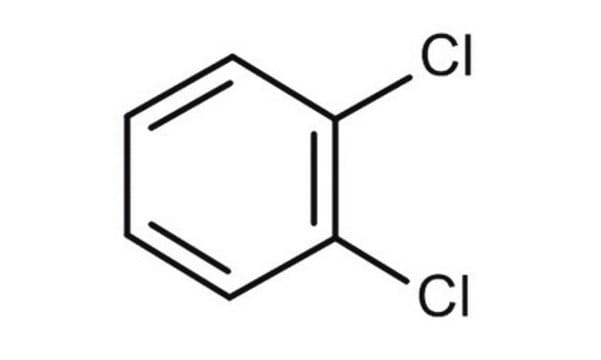270598
1,2-Dichlorobenzene
suitable for HPLC, 99%
About This Item
Prodotti consigliati
Densità del vapore
5.1 (vs air)
Tensione di vapore
1.2 mmHg ( 20 °C)
1.6 mmHg ( 35 °C)
Saggio
99%
Forma fisica
liquid
Temp. autoaccensione
1198 °F
Purificato mediante
glass distillation
Limite di esplosione
9.2 %
tecniche
HPLC: suitable
Impurezze
<0.020% water
Residuo dopo evaporazione
<0.0005%
Indice di rifrazione
n20/D 1.551 (lit.)
P. eboll.
178-180 °C (lit.)
Punto di fusione
−18-−17 °C (lit.)
Densità
1.306 g/mL at 25 °C (lit.)
λ
H2O reference
Assorbanza UV
λ: 296 nm Amax: 1.00
λ: 300 nm Amax: 0.30
λ: 305 nm Amax: 0.20
λ: 335 nm Amax: 0.05
λ: 375-400 nm Amax: 0.01
Stringa SMILE
Clc1ccccc1Cl
InChI
1S/C6H4Cl2/c7-5-3-1-2-4-6(5)8/h1-4H
RFFLAFLAYFXFSW-UHFFFAOYSA-N
Cerchi prodotti simili? Visita Guida al confronto tra prodotti
Categorie correlate
Applicazioni
- Microstructure regulation and enhanced VOC removal performance of carbon aerogels by surface carbon nanotube grown.: This study presents a new method to enhance the removal of volatile organic compounds, including 1,2-Dichlorobenzene, using surface-modified carbon aerogels (Cheng et al., 2024) (Cheng et al., 2024).
- Role of Electronegativity in Environmentally Persistent Free Radicals (EPFRs) Formation on ZnO.: This research investigates how surface chemistry affects the formation of persistent free radicals, including those from 1,2-Dichlorobenzene on zinc oxide surfaces (Ahmed et al., 2024) (Ahmed et al., 2024).
- Cu(I) Complexes Catalyzed the Dehydrogenation of N-Heterocycles.: This article discusses the application of copper(I) complexes in catalyzing the dehydrogenation of N-heterocycles, including reactions involving 1,2-Dichlorobenzene derivatives (Shen et al., 2024) (Shen et al., 2024).
- New Features of Laboratory-Generated EPFRs from 1,2-Dichlorobenzene (DCB) and 2-Monochlorophenol (MCP).: This publication explores the characteristics of laboratory-generated free radicals from 1,2-Dichlorobenzene, shedding light on its environmental impact and degradation processes (Khachatryan et al., 2024) (Khachatryan et al., 2024).
- Estimate of the C-Cl photoionization cross section and absolute photoionization cross sections of chlorinated organic compounds.: This study provides critical data on the photoionization properties of chlorinated organic compounds, including 1,2-Dichlorobenzene, which is important for understanding its behavior in atmospheric chemistry (Chen et al., 2024) (Chen et al., 2024).
Avvertenze
Warning
Indicazioni di pericolo
Classi di pericolo
Acute Tox. 4 Inhalation - Acute Tox. 4 Oral - Aquatic Acute 1 - Aquatic Chronic 1 - Eye Irrit. 2 - Skin Irrit. 2 - Skin Sens. 1B - STOT SE 3
Organi bersaglio
Respiratory system
Codice della classe di stoccaggio
6.1C - Combustible acute toxic Cat.3 / toxic compounds or compounds which causing chronic effects
Classe di pericolosità dell'acqua (WGK)
WGK 2
Punto d’infiammabilità (°F)
150.8 °F - closed cup
Punto d’infiammabilità (°C)
66.0 °C - closed cup
Certificati d'analisi (COA)
Cerca il Certificati d'analisi (COA) digitando il numero di lotto/batch corrispondente. I numeri di lotto o di batch sono stampati sull'etichetta dei prodotti dopo la parola ‘Lotto’ o ‘Batch’.
Possiedi già questo prodotto?
I documenti relativi ai prodotti acquistati recentemente sono disponibili nell’Archivio dei documenti.
I clienti hanno visto anche
Il team dei nostri ricercatori vanta grande esperienza in tutte le aree della ricerca quali Life Science, scienza dei materiali, sintesi chimica, cromatografia, discipline analitiche, ecc..
Contatta l'Assistenza Tecnica.










![N-[5-(Phenylamino)-2,4-pentadienylidene]aniline monohydrochloride 98%](/deepweb/assets/sigmaaldrich/product/structures/365/246/6dec3589-6c56-4b0a-a3ae-e8d5fbbd3f05/640/6dec3589-6c56-4b0a-a3ae-e8d5fbbd3f05.png)